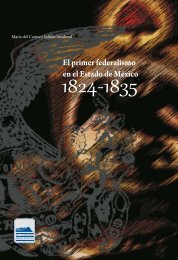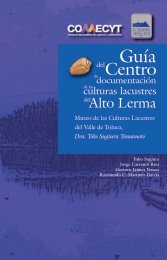You also want an ePaper? Increase the reach of your titles
YUMPU automatically turns print PDFs into web optimized ePapers that Google loves.
SUSIE S. PORTER, TOWARDS A HISTORY OF SEXUAL HARASSMENT IN THE WORKPLACE, MEXICO (1920-1950)<br />
included Ignacio Ramírez Arriaga and Antonio<br />
Ramos Pedrueza y Castañeda, the latter<br />
replaced by José Almaráz. They were soon<br />
joined by Enrique C. Gudiño and Manuel<br />
Ramos Estrada. Their work led to the 1929<br />
Penal Code, which, upon facing criticism for<br />
being overly positivistic, was again revised<br />
in 1931 (Almaráz, 1931; Santillán Esqueda,<br />
2016: 140). The 1931 Penal Code retained<br />
the requirement that “the crime of atentado<br />
contra el pudor can only be punished if<br />
the attempt has in fact been accomplished”<br />
(article 261); and that “the offended woman,<br />
her parents, or in the absence of those, her<br />
legal representative”, must file a complaint<br />
for a case to be pursued (article 263). Whereas<br />
the 1872 Penal Code made explicit reference<br />
to a criminal act “regardless of sex”<br />
(article 789), in 1929 atentado contra el pudor<br />
was more narrowly construed as a crime<br />
committed against women. The 1931 Penal<br />
Code retained the language from 1929, with<br />
the notable exception of specifying atentado<br />
contra el pudor as “an erotic-sexual act”<br />
that does not result in copulation (Secretaría<br />
de Gobernación, 1931:59)<br />
The other space where one might look<br />
for legislation regulating workplace sexual<br />
harassment is labor law. The Constitution<br />
of 1857 acknowledging the right of all Mexicans<br />
to an honest means of making a living<br />
but said little more about workers’ rights.<br />
Mexican labor law shifted significantly after<br />
the Revolution. Worker mobilization, strikes,<br />
and demands informed the Constitution of<br />
1917 that identified social groups such as<br />
workers. Article 123 used the word obreros<br />
to specifically to identify workers. During<br />
the 1920s workers and the courts debated<br />
who, precisely was an obrero. After a series<br />
of cases that resulted in contradicting findings,<br />
the Supreme Court determined that<br />
public employees were not obreros and so<br />
while Article 123 might serve as a guide, it<br />
did not pertain to public employees. Subsequently,<br />
Section A of Article 123 referred<br />
to obreros, or workers, and Section B addressed<br />
empleados, meaning public employees.<br />
The Constitution made specific<br />
provisions for obreras. Article 123, Section<br />
V guarantees working women who become<br />
pregnant shall have access to paid maternity<br />
leave before and after giving birth. They<br />
are also promised job security. Once having<br />
returned to work, a new mother also has the<br />
right to nurse her newborn child. Constitutional<br />
articles addressing women’s rights as<br />
workers did not include acknowledgement<br />
of sexual harassment.<br />
The rights outlined in the Constitution<br />
of 1917 would need to be elaborated upon<br />
in subsequent legislation, as was the case<br />
with Article 123. The 1920s saw heightened<br />
worker mobilization and legislators debated<br />
how to create legislation that would regulate<br />
workers’ constitutional guarantees. In<br />
1929 the Federal government produced the<br />
“Propuesta de ley federal <strong>del</strong> trabajo”. The<br />
Ministry of the Interior called a worker-employer<br />
congress to elicit feedback and the<br />
proposal was then debated in congress on<br />
November 15, 1928. The Ministry of Industry,<br />
Commerce, and Labor drew up the proposal,<br />
designating it law rather than a code. Congress<br />
debated the proposed law and approved<br />
it as the Ley Federal <strong>del</strong> Trabajo (LFT)<br />
on August 18, 1931. The LFT addressed the<br />
constitutional guarantees regarding maternity<br />
leave and the right to nurse a newborn<br />
child (DOF, 1931: <strong>21</strong>; DOF, 1938: 3). Article<br />
22, Section V, stated that contracts would<br />
be null and void if, based on “age, sex, or<br />
nationality”, workers were not given equal<br />
pay for equal work (DOF, 1931: 6.) The LFT<br />
also addressed how employer obligations to<br />
workers, exhorting them to “treat workers<br />
with all due respect, abstaining from abuse<br />
in word or action” (DOF, 1931: 6.)<br />
The Supreme Court and the federal government<br />
had both argued that as employees<br />
of the State, public employees did not<br />
enjoy the same constitutional rights as obreros.<br />
When this became clear, public employees<br />
quickly mobilized to secure the same<br />
rights as those granted to workers. They<br />
split, however, over whether they wanted to<br />
be included in the Federal Labor Law or supported<br />
an initiative for a Civil Service Law.<br />
In 1938, the Federal government published<br />
the Estatuto Jurídico de los Trabajadores al<br />
124



![bicentenario_1[V2]](https://img.yumpu.com/68677971/1/167x260/bicentenario-1v2.jpg?quality=85)
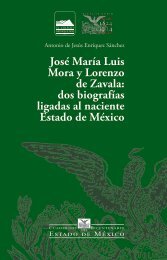
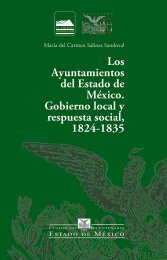

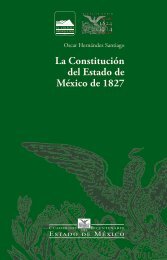
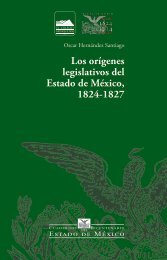
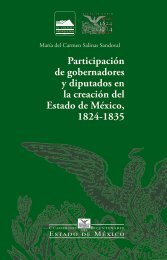
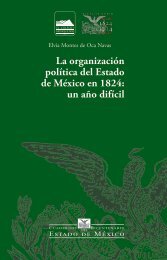
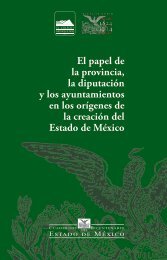

![El_primer_federalismoEM[final]_compressed (2)](https://img.yumpu.com/68483279/1/178x260/el-primer-federalismoemfinal-compressed-2.jpg?quality=85)
